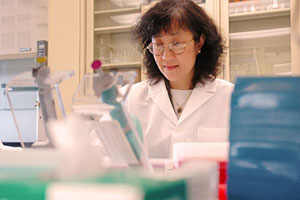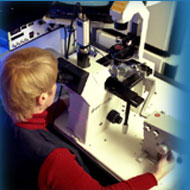
Environmental Factor, May 2008, National Institute of Environmental Health Sciences
Grant Awarded for BPA-Epigenetics Research
By Eddy Ball
May 2008

The NIEHS Division of Extramural Research and Training (DERT) approved a fourth five-year renewal of a center grant to the Center for Environmental Genetics (CEG) at the University of Cincinnati College of Medicine (UCCM) Department of Environmental Health. The renewal coincided with a $2.6 million R01 grant award to co-principal investigators Professor Shuk-Mei Ho, Ph.D., CEG director and chair of Environmental Health at UCCM, and Professor Gail Prins, Ph.D., of the University of Illinois Chicago.
According to DERT Health Science Administrator Les Reinlib, Ph.D., director of the Environmental Health Sciences (EHS) Core Centers(http://www.niehs.nih.gov/research/supported/centers/core/index.cfm) program, UCCM has reason to be proud of its success. “This is a highly competitive year for Core Center funding,” he said. “Our budget is limited this year, and we were looking very carefully for a strong emphasis on translation and clinical application.”
The grant will allow Ho(http://www.eh.uc.edu/dir_individual_details.asp?qcontactid=702) ![]() and Prins(http://www.uic.edu/labs/prins/Gail.htm)
and Prins(http://www.uic.edu/labs/prins/Gail.htm) ![]() to continue their preliminary investigations into the role of neonatal exposures to the endocrine disrupting compound Bisphenol A (BPA) in triggering gene expression changes involved in prostate cancer caused by epigenetic modifications. These epigenetic changes are typically defined as heritable modifications that do not involve alternations in the primary DNA sequence.
to continue their preliminary investigations into the role of neonatal exposures to the endocrine disrupting compound Bisphenol A (BPA) in triggering gene expression changes involved in prostate cancer caused by epigenetic modifications. These epigenetic changes are typically defined as heritable modifications that do not involve alternations in the primary DNA sequence.
In August 2007, Ho presented the team’s findings(http://www.niehs.nih.gov/news/newsletter/2007/october/edc.cfm) ![]() at an NIEHS-sponsored meeting in Durham, N.C., “Future Research on Endocrine Disruption: Translation of Basic and Animal Research to Understand Human Disease.” Ho and Prins demonstrated that neonatal exposure of rats to BPA elicits epigenetic modifications of specific genes, which is attended by aberrant gene expression, increased incidences of pre-cancerous lesions and a greater likelihood of developing cancer in the prostates of exposed animals.
at an NIEHS-sponsored meeting in Durham, N.C., “Future Research on Endocrine Disruption: Translation of Basic and Animal Research to Understand Human Disease.” Ho and Prins demonstrated that neonatal exposure of rats to BPA elicits epigenetic modifications of specific genes, which is attended by aberrant gene expression, increased incidences of pre-cancerous lesions and a greater likelihood of developing cancer in the prostates of exposed animals.
With their new grant, the scientists plan to explore in greater detail the relationship between aberrant DNA methylation and abnormal expression of prostatic gene found in their earlier studies to result from early life estrogenic exposures. They also want to uncover additional genes susceptible to developmental reprogramming through methylation and determine if they contribute to increased carcinogenic potential in the early-life estrogenization of the animals’ prostate glands.
The team’s ambitious research agenda includes determining the dose-response relationship for the effects of BPA on prostate and the points during development when animals are most susceptible. Using a novel tissue recombination model, the investigators will test whether BPA modifies carcinogenic susceptibility and methylation patterns in human prostate-like structures. They will strive to identify in detail the altered rat prostate methylome, the cell epigenetic program that controls the expression of genetic information.
This systems biology approach will take advantage of high-throughput ‘omics methodologies, such as methylation-sensitive fingerprinting (MSRP) and methylation arrays, to expand the researchers’ prostatic screen. The team will compile a full panel of candidate genes and a stringent algorithm in order to relate candidate genes to regulatory CpG islands, the regions of dense CpG content normally protected from DNA methylation in vertebrates but found frequently to be methylated in cancer.
Finally, the team’s grant proposal calls for direct experiments to demonstrate the causal link of candidate gene epigenetic modification by estrogenic exposure to prostate gland carcinogenesis. The investigators will use a variety of in vitro and in vivo studies to fulfill this aim of the study.
For Ho, the fourth director of the 15-year-old center, the grant renewal is a major accomplishment and an important part of her long-term research plans (see text box). “Our program was successful, I think, largely because of our long-term commitment to translation, clinical applications, training and an aggressive program for expanding our Informatics Core,” she said.
The University of Cincinnati’s Center is one of 22 EHS Core Centers funded by NIEHS. The EHS Core Centers Program creates an infrastructure for development of novel technologies and approaches that can be brought to bear on new and existing research projects.
Looking beyond BPA
Even as she prepares what she described as “very mechanistic” studies on BPA and estradiol exposures, Shuk-Mei Ho is already thinking in broader terms about the phenomenon of epigenetics and its role in human health. Her ultimate goal is nothing less than the transformation of the practice of medicine itself. As she describes the transformation in a recent paper in press, Ho envisions a “personalized, preventive medicine based, in part, on [new insights into] the epigenetic markings etched in the ‘margins’ of one’s genetic make-up.”
In addition to her work with Prins on BPA, over the past year Ho has explored additional dimensions of epigenetics with colleagues at UCCM, NIEHS researcher Retha Newbold, University of Missouri-Columbia biologist Frederick vom Saal, Ph.D., and Columbia University physician-scientist Rachel Miller, M.D. With Newbold and vom Saal, she has explored epigenetic alterations in multiple animal models. With Miller, she reviewed the influence of DNA methylation of genes critical to T helper cell differentiation that may induce polarization towards or away from an allergic or asthmatic phenotype. Finally, she has considered the links between epigenetic changes and multiple toxicants, mineral and nutrient deficiencies, and obesity.
At this point in her research, Ho admits, “There are more questions than answers.” She and co-author Wan-yee Tang, Ph.D., of UCCM, concluded a recent paper, which is now in press for Reviews of Endocrinology and Metabolic Disorders, with a list of six key unanswered questions. These include the reversal of epigentic imprinting and marks, the “mixtures” effects of multiple simultaneous environmental exposures, critical windows in development and adulthood, and surrogate markers and interventions that can be utilized as therapies.
“If we can understand how to reverse epigenetic alterations, we have enormous therapeutic opportunity,” she explains. “That’s why I’m so passionate about this research.”
"Laureate Cautious..." - previous story ![]()
![]() next story - "Brain Study May Lead..."
next story - "Brain Study May Lead..."
May 2008 Cover Page



